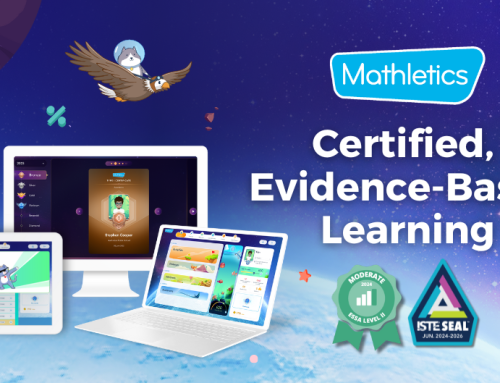At International School Utrecht (ISU), educators faced a complex challenge: how to effectively teach mathematics to a multilingual student body while balancing the rigorous standards of both the International Baccalaureate (IB) Primary Years Programme (PYP) and Common Core curricula.
Year 3 teacher and maths specialist Tayla Webb sought a solution that blended enquiry-based learning with structured maths practice, catered to students learning in a second language and engaged learners across all ability levels.
This case study reveals how ISU’s approach to integrating our online maths programs, Mathletics and Mathseeds, not only addressed these challenges but also yielded unexpected benefits in student engagement and independent learning.
From supporting newcomers with limited English to challenging advanced learners, ISU’s journey offers valuable insights for international schools aiming to enhance maths instruction in today’s global classroom.
The challenge: Addressing diverse learning needs
ISU’s multilingual student body presented unique challenges in maths education. Tayla explains:
“Because we’re an international school it’s an ever-changing environment and sometimes there are students who join in the middle of the year that are new to English. That’s a challenge because on one hand we’re trying to understand what they know mathematically and what is hindering them with the language.”
The school identified several key challenges:
- Aligning resources with their hybrid curriculum
- Supporting visual learning for students from diverse backgrounds
- Facilitating both home and school use
- Providing robust differentiation to accommodate varied student needs
- Assisting students learning maths in English as an additional language (EAL).
Tayla elaborates on their search for a solution:
“We were trying to find maths programs that would tick ALL the boxes… and weren’t solely based on the curriculum and answering rote questions but also focused on the visual learning of maths concepts and that could provide maths practice at home and at school.”
The solution: Comprehensive digital tools for maths education
After a thorough evaluation process, ISU selected Mathletics and Mathseeds for their features that aligned well with the school’s needs:
- Visual learning support: Particularly beneficial for EAL students.
- Differentiation capabilities: Allowing teachers to tailor content to individual needs
- Home learning support: Built-in explanations facilitating independent practice
- Enquiry-based approach: Encouraging student agency and ownership of learning
- Curriculum alignment: Complementing the combined Common Core and IB PYP approach
- Engagement across age groups: Catering to students of all abilities.
Tayla notes the particular benefits for EAL students:
“Mathseeds lends well towards students who struggle with English because it’s so child-friendly. It’s not as overwhelming for a student who comes in new to English and it’s structured in a way that they know where to go. The student does a placement test and can make meaning of visuals… so they can still solve and show their understanding of maths without being hindered by the language.”
The school also found value in choosing both Mathletics and Mathseeds to support learners at different stages. Tayla recounts:
“We brainstormed different options and explored various maths programs. After weighing the pros and cons, Mathletics and Mathseeds really stood out. With Mathseeds we loved how fun and engaging the program is as it’s so important that children develop a love for maths when they’re young… and then it develops more structurally as you move on to Mathletics.”

Implementation: A supportive transition process
The transition to Mathletics and Mathseeds was marked by a supportive and flexible implementation process. Key elements included:
- Comprehensive demonstration of program features
- Clear and consistent communication throughout the trial period
- Flexible scheduling to accommodate the school’s academic calendar
- Ongoing assistance and targeted training during peak times.
Tayla shares her experience:
“Our contact was really amazing with checking in and extending our trial due to the holidays… we received really clear communication. It was very open and I could always email any questions. There’s an understanding that it’s a busy time of the year, but there’s still a fast response and wonderful support.”

Early observations: Positive trends in student engagement and learning
Although still in the initial stages of implementation, ISU has noted several positive trends:
- Increased student engagement: Tayla observes, “As much as I knew it was child-friendly and fun, I didn’t expect it to be as engaging as it is. The children really fell in love with the programs immediately.”
- Support for independent learning: Students have quickly adapted to using the programs autonomously. Tayla notes, “I see how easy it is for the students… as soon as they get into a routine, I notice that in terms of being able to do a task and complete it by themselves, that’s something they’re able to do.”
- Data-driven instruction: Teachers now have access to detailed progress monitoring tools. Tayla explains, “You can immediately see which students need more reinforcement and practice, which students get it and which ones are actually repeating that learning to show they’ve really understood.”
- Personalised learning: The programs’ differentiation capabilities allow for customisation within and across grade levels. Tayla appreciates that “if there are some students who maybe aren’t mathematically developed mentally and ready for grade 3 content, you can differentiate and make groups that best suit them.”
- Language support: Visual elements and an intuitive interface have proven beneficial for EAL students. Tayla observes, “The way the questions are asked is really visual and there are a lot more elements of critical thinking and giving reasoning to your answers. There are a lot of different elements of maths practice that lean towards more enquiry-based learning and visualisation is so important.”
The school has found particular value in using both programs in conjunction:
“We noticed that Mathseeds lends itself more towards the younger ages and then Mathletics from grade 3. But we also know that grade 3 is such a transition year. Some students might not be ready for Mathletics and for other students, Mathseeds and how it’s structured is maybe better. The differentiation capabilities really sold us on these maths programs because they can be so easily differentiated… and for a student who might feel really anxious about maths, having access to both programs is beneficial.”

Looking ahead: Integrating technology for long-term maths success
ISU’s implementation of Mathletics and Mathseeds has shown promising early results, effectively addressing the school’s unique challenges.
The programs have successfully supported diverse learners, aligned with the hybrid curriculum and enhanced maths instruction across various levels.
Key outcomes include increased student engagement, improved independent learning, data-driven instruction and effective support for EAL students.
Tayla summarises the impact:
“The programs allow for regular practice and that’s really what you need with maths. The big takeaways are the opportunity for feedback…it gives you such quick results…it allows us to give feedback and students’ learning progresses from there and that’s something we’re all grateful for.”
Key takeaways:
- Successful integration of Common Core standards with IB PYP framework
- Observed increase in student engagement and independent learning
- Effective support for diverse learners, including EAL students
- Improved continuity between home and school learning environments
- Reinforcement of enquiry-based learning principles and student agency.
Discover 3 Essentials: Comprehensive, integrated learning for your school
Inspired by success stories like International School Utrecht? Take the next step in strengthening your school’s resources.
3 Essentials brings together our evidence-based programs for reading, writing and maths – including Mathletics and Mathseeds – into a single, cost-effective package that offers exceptional value for schools.
Learn how 3 Essentials can drive student success in your school. Visit the 3 Essentials website today to explore the possibilities.







